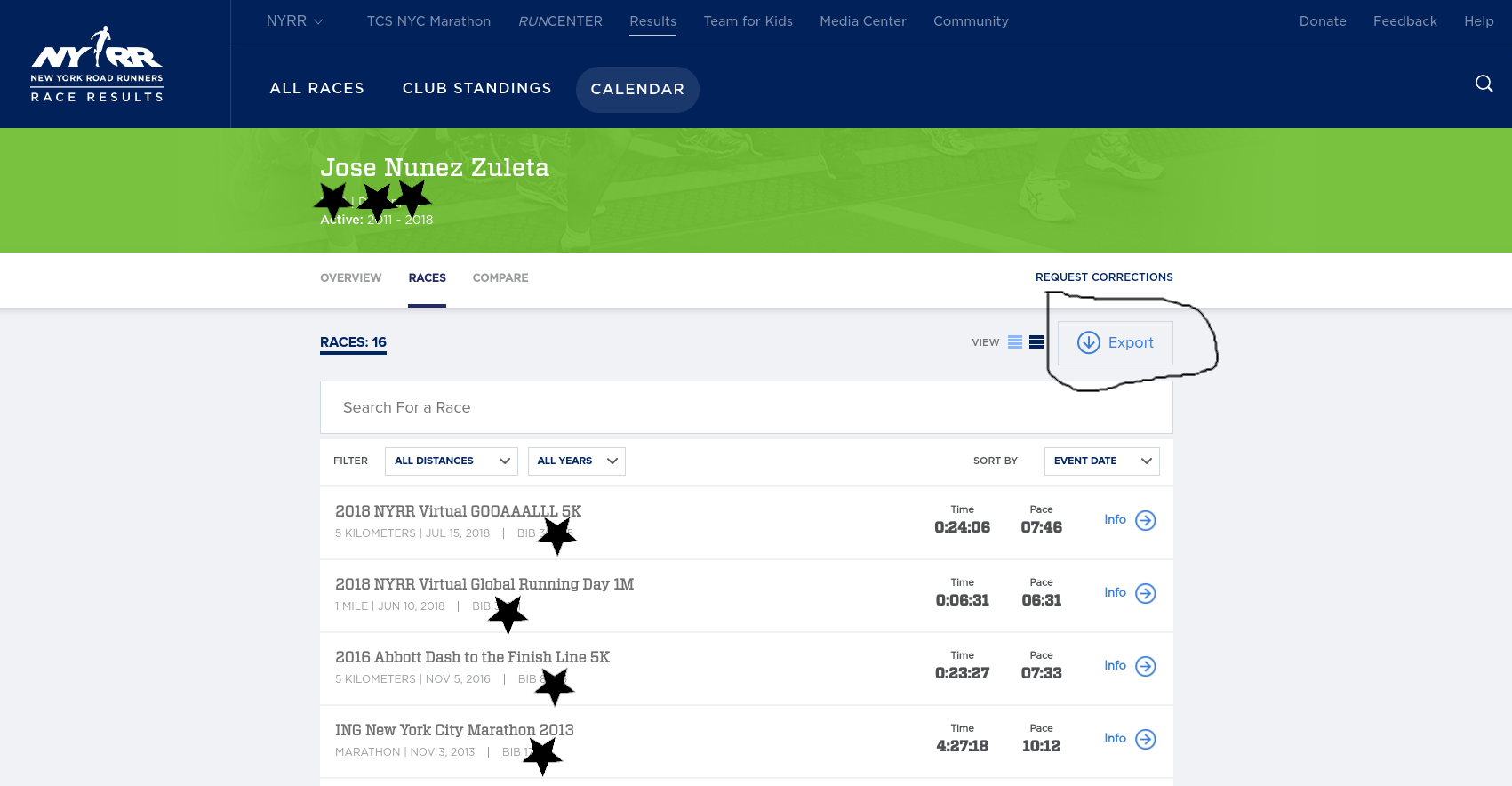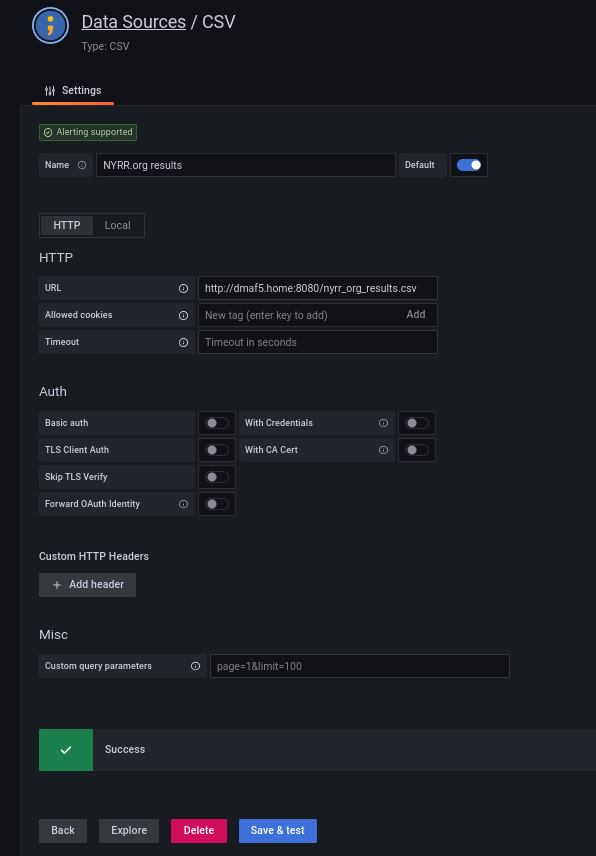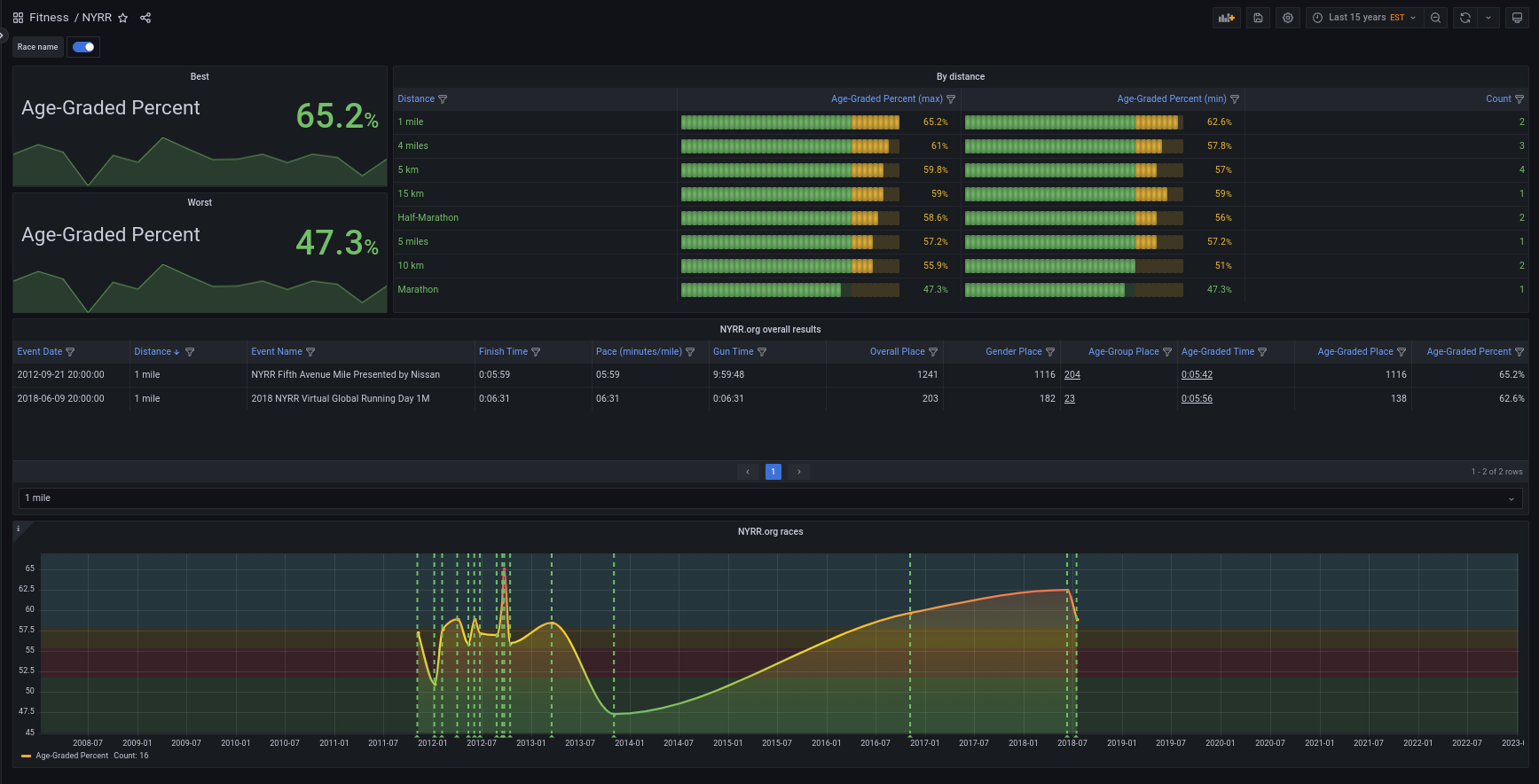Building a Grafana dashboard to visualize your NYRR.org race results using Ansible, Podman and Buildah

If you live or work in New York and like running you may have run one of the New York Road Running races. You may know perhaps one of their most famous races, the NYRR Marathon.
So who are they?
Our history is rich because we run with passion. It all started with a local running club made up of just 40 people, but over the past 60+ years, committed runners have joined us in droves. Time, commitment, and our never-ending mission to help and inspire people through running have led us to become the world’s premier community running organization.
Over the years I ran many of their races, and it is not surprise they have one of the biggest databases of races for many distances (like 5K, Marathon). Curious, I downloaded a full list of my race results into Excel format, massaged it a bit and then started asking more questions.
In this tutorial I will show how to:
- Set up a Podman container that provides access to your race history in CSV format
- Set up a CSV data-source in Grafana
- Create a dashboard that shows multiple views of the same data, including annotations.
Requirements
- Ability to install software as root on a Linux distribution (I used Fedora, feel free to run anything else you like)
- Python 3. Comes pre-installed on most Linux distributions
- Podman. Don’t worry, I will show you how to install it later.
- Grafana (running in a container, but a bare-metal installation also works). Also with the ability to install plugins, like the CSV plugin.
But the most important requirement is curiosity.
Right now, let’s install Ansible (if it is not there) so you can get started. In Fedora you can install Ansible using DNF:
sudo dnf -y install ansible
For other distributions, consult Ansible install instructions.
You also need some extra tools for Ansible, like Podman support:
ansible-galaxy collection install containers.podman
The data file
Once you download your data from their webpage in Excel format, you need to do a bit of editing and export the resulting file to CSV:

The resulting CSV looks more or less like this:
Event Name,Event Date,Distance,Finish Time,Pace,Gun Time,Overall Place,Gender Place,Age-Group Place,Age-Graded Time,Age-Graded Place,Age-Graded Percent
2018 NYRR Virtual GOOAAALLL 5K,07/15/2018,5 km,0:24:06,07:46,0:24:06,516,469,59,0:22:02,375,58.97
2018 NYRR Virtual Global Running Day 1M,06/10/2018,1 mile,0:06:31,06:31,0:06:31,203,182,23,0:05:56,138,62.57
2016 Abbott Dash to the Finish Line 5K,11/05/2016,5 km,0:23:27,07:33,0:29:40,1055,819,94,0:21:44,723,59.76
ING New York City Marathon 2013,11/03/2013,Marathon,4:27:18,10:12,4:29:56,27160,19238,4046,4:19:57,21389,47.30
The resulting CSV is very simple, no need for further transformations.
Next step is to make this CSV file available over HTTP, so it can be used by Grafana. For that you will use a Podman container.
Making sure you have the proper tools installed
Next step is to write an Ansible playbook, with the suggested structure where you put files, templates, and the instructions to get everything installed and started in the proper order.
The resulting Ansible playbook (nyrr_podman_provisioning.yaml)
- name: Tasks to get a NYRR race dashboards up and running
hosts: localhost
tasks:
- name: Toolchain preparation
block:
- name: Install Podman
ansible.builtin.dnf:
name: podman
state: installed
become: true
tags: toolchain
Then run it with ansible-playbook --tags toolchain roles/races/nyrr_podman_provisioning.yaml to install Podman.
Creating the web application to provide the NYRR results CSV over HTTP
The application is fairly simple:
- Serve a static file over HTTP, the python3.11 slim image will work just well:
- Only need to drop the race results CSV file on the
/home/josevnz/fitnessdirectory (or similar directory on your machine) and the webserver will pick it up. You can use (nyrr_org_results.csv) to get you started. - To visualize the results, you will use containerized Grafana with a few pre-installed plugins
Chicken-and-egg problem with the Grafana container
We have a classic “what was first, the chicken or the egg” problem here, because:
- You need a Grafana instance running, in order to setup a datasource and then implement the dashboard, but you want to be able to restore your Grafana instance easily, most likely on a more powerful server
- You could argue you can create a datasource first, then spin a Grafana container and then implement the dashboard. But that is not how things are done in reality.
You can see that Ansible is not needed for the test Grafana instance, but still a bit of automation is desired (like installing custom plugins).
I will run both the home_fitness webserver and the Grafana containers from the same location, also because we will mount the CSV from out home directory we need to pass a special SELinux flag so the container can use the mounted file.
podman run --name nyrr_server --publish 8080:8080 --security-opt label=disable --volume /home/josevnz/fitness/nyrr_org_results.csv:/mnt/nyrr_org_results.csv:ro --restart=always --detach --workdir /mnt python:3.11-slim python3 -m http.server 8080
1c0c23ad9240c8b606bb1c9e8d585b89e1b7718d15c81088f25533f34c3b03b6
Then using a tool like curl you can try to download the processed copy of the NYRR race results:
[josevnz@dmaf5 NYRR]$ curl --fail --verbose --silent --url http://localhost:8080/nyrr_org_results.csv
* Trying 127.0.0.1:8080...
* Connected to localhost (127.0.0.1) port 8080 (#0)
> GET /nyrr_org_results.csv HTTP/1.1
> Host: localhost:8080
> User-Agent: curl/7.85.0
> Accept: */*
>
* Mark bundle as not supporting multiuse
* HTTP 1.0, assume close after body
< HTTP/1.0 200 OK
< Server: SimpleHTTP/0.6 Python/3.11.1
< Date: Thu, 02 Feb 2023 02:30:45 GMT
< Content-type: text/csv
< Content-Length: 1775
< Last-Modified: Thu, 02 Feb 2023 01:16:26 GMT
<
Event Name,Event Date,Distance,Finish Time,Pace,Gun Time,Overall Place,Gender Place,Age-Group Place,Age-Graded Time,Age-Graded Place,Age-Graded Percent
2018 NYRR Virtual GOOAAALLL 5K,07/15/2018,5 km,0:24:06,07:46,0:24:06,516,469,59,0:22:02,375,58.97
2018 NYRR Virtual Global Running Day 1M,06/10/2018,1 mile,0:06:31,06:31,0:06:31,203,182,23,0:05:56,138,62.57
2016 Abbott Dash to the Finish Line 5K,11/05/2016,5 km,0:23:27,07:33,0:29:40,1055,819,94,0:21:44,723,59.76
ING New York City Marathon 2013,11/03/2013,Marathon,4:27:18,10:12,4:29:56,27160,19238,4046,4:19:57,21389,47.30
NYC Half 2013,03/17/2013,Half-Marathon,1:42:31,07:50,1:50:39,2322,1760,277,1:39:42,1989,58.56
Grete's Great Gallop in Support of AKTIV Foundation,10/14/2012,Half-Marathon,1:48:34,08:17,1:51:27,1508,1154,237,1:45:02,1267,56.00
NYRR Fifth Avenue Mile Presented by Nissan,09/22/2012,1 mile,0:05:59,05:59,9:59:48,1241,1116,204,0:05:42,1116,65.19
Fitness Games Men,09/15/2012,4 miles,0:29:07,07:17,0:29:55,480,480,97,0:27:43,535,61.00
Percy Sutton Harlem 5K Run,08/25/2012,5 km,0:23:50,07:41,0:25:10,975,771,130,0:22:42,803,57.00
Achilles Hope & Possibility,06/24/2012,5 miles,0:38:38,07:44,0:39:05,386,326,75,0:37:18,409,57.17
Celebrate Israel,06/03/2012,4 miles,0:30:04,07:31,0:31:52,856,748,143,0:28:38,829,59.00
UAE Healthy Kidney 10K,05/12/2012,10 km,0:49:15,07:56,0:51:29,1886,1567,308,0:47:49,1728,55.89
New York Colon Cancer Challenge 15K,04/01/2012,15 km,1:12:47,07:49,1:13:13,651,544,118,1:09:53,594,59.00
NYRR Gridiron Classic,02/05/2012,4 miles,0:30:28,07:37,0:33:45,1173,960,174,0:29:15,1099,57.80
Joe Kleinerman 10K,01/07/2012,10 km,0:55:05,08:52,0:59:35,2423,1708,316,0:52:51,1850,51.00
NYRR Dash to the Finish Line (5K),11/05/2011,5 km,0:23:36,07:36,0:25:32,593,471,90,0:22:40,562,57.28
* Closing connection 0
Or a simpler way, which you will use for the container self health check:
python3 -c 'import urllib.request; import sys; urllib.request.urlopen("http://localhost:8080/nyrr_org_results.csv").readlines(); sys.exit(0)' && echo "SUCCESS"|| echo "FAILURE"
Next you will do something similar to spin a throw away Grafana instance that you will use for development
Throw away Grafana instance
Again, let’s create another container, this time for Grafana:
podman run --rm --detach --publish 3000:3000 --name=grafana_test --env "GF_INSTALL_PLUGINS=marcusolsson-csv-datasource,marcusolsson-json-datasource" grafana/grafana-oss:latest
porman logs --follow grafana_test
The container can be customized further, to include required plugins and persistent volumes, when is restarted the installation data will be preserved.
Time to focus on visualizing the race results.
Creating and provisioning the datasource and the dashboard
Once the instance is up, you can log in the first time with user admin and password admin. Then, add a CSV datasource (example shown below):

Designing the Dashboard is something you do by interactively, and most likely after several attempts you end up having something that you like.
So let’s outline the steps for this one:
- Show a time series with the age graded percentile (best, worst)
- A table showing overall race results, with the ability to filter
A detailed tutorial on how create and best practices for dashboards is beyond the scope of this tutorial, but you can see the end results of creating a dashboard:

To be able to treat this as code, export the dashboard definition as JSON and save it to a file:

To provision as code, tell Grafana where it can pick the dashboards (default.yaml):
apiVersion: 1
providers:
- name: Jose dashboards providers
type: file
updateIntervalSeconds: 10
options:
path:
/etc/grafana/provisioning/dashboards
foldersFromFilesStructure: true
The dashboard you exported earlier ([NYRR-1675298041762.json]) will be also copied to the right directory.
Next we will take care of the datasource. The datasource can also be defined as a yaml file on a special directory (nyrr_race_results_datasouce):
apiVersion: 1
datasources:
- name: DS_NYRR.ORG_RESULTS
type: marcusolsson-csv-datasource
uid: ""
url: "http://:8080/"
editable: true
jsonData:
storage: http
Note that you can use Jinja expressions to refine the datasource behaviour, like passing overrides to the plugin. Do it on a special plugin file, csv.yaml
---
apiVersion: 1
apps:
- type: marcusolsson-csv-datasource
org_id: 1
disabled: false
jsonData:
allow_local_mode: true
All these artifacts are deployed on an external volume that is mounted by the Grafana container.
To recap you now have the following:
- Web server to provide the race results over HTTP
- A CSV datasource that can ingest the CSV file
- A Dashboard to display the results
Time to provision all the pieces using Ansible.
Launching the containers from Ansible
Ansible offers support for podman, so you can augment the previous playbook with extra instructions.
At the end, your nyrr_podman_provisioning.yaml looks like this:
---
- name: Tasks to get a NYRR race dashboards up and running
hosts: localhost
vars:
race_results_dir: /home/josevnz/raceresults # Update this path
grafana_data_dir: /home/josevnz/grafana_raceresults_data # Update this path
nyrr_race_results_file: nyrr_org_results.csv
datasource_id: 948e72a8-a6cc-11ed-a1ef-1c8341284421 # uuidgen --time
nyrr_service_host: dmaf5.home # Replace with your host name
nyrr_service_port: 8080
nyrr_service_tag: 3.11-slim
grafana_plugins: marcusolsson-csv-datasource,marcusolsson-json-datasource
grafana_service_port: 3000
tasks:
- name: Toolchain preparation
tags: toolchain
ansible.builtin.dnf:
name: podman
state: installed
become: true
- name: Provision data services
tags: data_services
block:
- name: Copy NYRR race results to
tags: copy_service_files
ansible.builtin.copy:
dest: "/"
src: ""
directory_mode: a+xr
mode: a+r,u+w
- name: Python3 image
tags: pull_service_image
containers.podman.podman_image:
name: python
tag: ""
- name: Launch containers required to see the race results
tags: launch_nyrr_data
containers.podman.podman_container:
init: true
name: "nyrr_server"
image: "python:"
command: "python3 -m http.server "
state: started
security_opt:
label=disable
restart_policy: "always"
detach: true
workdir: /mnt
rm: false
ports:
- ":"
expose:
- ""
volumes:
- "/:/mnt/:ro"
healthcheck: "python3 -c 'import urllib.request; import sys; urllib.request.urlopen(\"http://localhost:/\").readlines(); sys.exit(0)'"
healthcheck_retries: 3
healthcheck_start_period: "10s"
- name: Provision visualization services
tags: visualization_services
block:
- name: Copy Grafana artifacts to final location
tags: copy_visualization_files
ansible.builtin.copy:
dest: "/"
src: ""
directory_mode: a+xr
mode: a+r,u+w
- name: Grafana image
tags: pull_service_image
containers.podman.podman_image:
name: "grafana/grafana-oss"
tag: "latest"
- name: Provisioning directories
tags: grafana_provision_dirs
ansible.builtin.file:
path: "/provisioning/"
mode: "ugo+xr,u+w"
state: "directory"
recurse: true
loop:
- access-control
- alerting
- dashboards/racing
- datasources
- notifiers
- plugins
- name: Launch Grafana container
tags: launch_grafana
containers.podman.podman_container:
init: true
name: "grafana_races"
image: "grafana/grafana-oss:latest"
state: started
security_opt:
label=disable
restart_policy: "always"
detach: true
rm: false
env:
GF_INSTALL_PLUGINS: ""
ports:
- ":"
expose:
- ""
volumes:
- "/provisioning:/etc/grafana/provisioning:rw"
- name: Deploy files to provision directories
tags: files_grafana
ansible.builtin.copy:
dest: "/"
src: ""
mode: a+r,u+w
loop:
- files/grafana/provisioning/dashboards/racing/NYRR-1675298041762.json
- name: Deploy templates to provision directories
tags: templates_grafana
ansible.builtin.template:
dest: "/"
src: ""
mode: a+r,u+w
loop:
- templates/grafana/provisioning/dashboards/default.yaml.j2
- templates/grafana/provisioning/datasources/nyrr_race_results_datasource.yaml.j2
- templates/grafana/provisioning/plugins/csv.yaml.j2
Note that for this to work on your environment, you will have to change some paths.
Running the Ansible playbook
Below is a capture of how the whole provisioning looks on my computer, plus a few quick inspection of the two running containers:
Race results dashboard in action
The whole vide of the Grafana instance, freshly created is here:
Conclusion
- There are other visualization tools out there, I like Grafana because is Open Source, workflow is easy to understand and the results are good but feel free to try anything else with your data.
- You don’t need a database to be able to manage your running data. A simple CSV or JSON file can be used for that purpose, but you can always make your datastore more sophisticated.
- Grafana ecosystem has other tools out there that can help you manage your datasources as code, allowing you to automate even more your process. In particular I like grafyaml as is well documented and mature.
- If you need to perform more complex tasks while provisioning your Grafana instances with Ansible, you may want to explore the ansible-grafana project. It uses Grafana REST API to perform very complex provisioning tasks with ease (keep in mind the project seems to be stale).
- Finally, support your non-profit local racing club. For example NYRR promotes youth running and over the years have helped to build community relationships not just New York state but with people from all over the world. If you like running, please consider participating in their organized races, donating or volunteering.